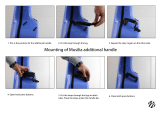
20
Troubleshooting
Problem Items to check Action
No sound / volume too low
Are the connection cables broken? Try using a dierent set of connection cables. - - -
Is the ES-8 correctly connected to the other devices? Check connections with the other devices. p. 2
Is the connected amp turned o, or the volume
lowered?
Check the settings of your amp/mixer system. - - -
Could the volume pedal have lowered the level? Advance the volume pedal. - - -
Could mute be turned on? Press the [MUTE] switch to turn mute o. p. 4
Is each eects set correctly? Check the settings of each eects. - - -
Is the power to the external device connected to the
SEND 1–8 and RTN 1–8 jacks o, or is the volume of the
device turned down?
Check the settings for the connected device. - - -
Could you be using a connection cable that contains
a resistor?
Use a connection cable that does not contain a resistor. - - -
Could you have turned o Input Buf and connected an
eect loop in parallel?
Depending on the impedance of the signal, the volume may
diminish. If you use a parallel connection, turn on Input Buf.
p. 9
Oscillating sound occurs
Could the gain value or the value of a volume-related
parameter be too high due to the settings of a
connected amp or eect unit?
Lower these values. - - -
Sound switches on its own
Could an external MIDI device be set to modify the
parameters?
Check the assignment settings.
p. 10
Is “INT” or “WAV” set as the Src in Assign?
When the Src is set to “INT” or “WAV,” the eect parameter set as
the Assign Target changes automatically.
Patch does not change
Is something other than the Play screen shown in the
display?
On the ES-8, patches can be selected only when the Play screen is
displayed. Press the [DISPLAY/EXIT] button several times to return
to the Play screen.
p. 5
Could you have changed the function of the [BANK
I
]
[BANK
H
] switches or the number switches [1]–[8]?
If the Func setting is set to OFF, change it to BnkD, BnkU, or
Num1–8.
p. 10
Sound does not change when you
switch patches
Are the loop settings of each patch correct? Check the loop settings. p. 9
Can’t change the settings of a
connected eect unit
Is the EXT CTL jack connected?
Is the cable the correct type (mono, TRS)?
Check the cable type and connection. p. 3
Can’t specify Carry Over / Can’t
specify parallel connection
Could you already be using both mixers?
There are two internal mixers.
Turn o one of the mixers you’re using, or change the stereo return
to mono return.
p. 7
p. 12
Could you have specied Carry Over or parallel
connection for a stereo-return loop?
Can’t use a controller to modify a
parameter
Could the loop be turned o? Turn the loop on. p. 6
Is the Preference setting set to anything other than
PAT?
To change the settings for an individual patch, set the Preference
setting to PAT. To change a specic setting for all patches in
common, select a setting other than PAT.
p. 12
Do the MIDI channel settings of both devices match? Make sure that the MIDI channels of both devices match.
p. 10
p. 12
Do the controller number settings of both devices
match?
Make sure that the controller number of both devices match.
When using an expression pedal,
the eect changes depending on
the patch
The eect of using an expression pedal will dier
depending on the patch.
Try out the eect beforehand. - - -
MIDI messages are not
transmitted/received
Are the MIDI cables broken? Try another set of MIDI cables. - - -
Are the MIDI cables connected correctly? Connect MIDI IN and MIDI OUT. - - -
Do the MIDI channel settings match?
Match the MIDI channel settings.
Receive channel of the ES-8: MIDI Setting
0
RxCh
Transmit channel of the ES-8: Patch MIDI 1–8
0
Ch
p. 12
p. 10
Hum is heard
Could the amp’s send/return be connected to the
volume loop?
In some cases, you can minimize hum by disconnecting pin
number 1 of the SEND VOL jack from the ES-8’s ground. Try
changing the Vol Loop Lift setting.
p. 12
Eect not applied Could the eect switch be o? Check the on/o setting of each eect. - - -
Error Messages
Display Problem Action
MIDI BUFFER FULL!
The data cannot be processed correctly due to the high
volume of MIDI messages.
Reduce the volume of MIDI messages transmitted to the ES-8.
- - -
Reduce the tempo of the transmitting MIDI device.
MIDI OFFLINE!
Transmissions from the connected device have been
interrupted. This message also appears when the
power to the connected device has been turned o. It
does not indicate damage.
Check to make sure no cable is disconnected and that there are
no shorts.
- - -
DATA WRITE ERROR! Writing to the memory for storage of user data failed.
The unit may be damaged. Consult the nearest Roland service
center.
- - -
LOCKED! The buttons are locked. Turn “Lock function” o. p. 4
NO MORE MIXERS ARE AVAILABLE! Both of the two internal mixers are already in use. Check the Loop Structure settings. p. 7, p. 9
SYSTEM ERROR! A problem has occurred in the system. Contact your dealer or a nearby Roland service center. - - -
MEMORY DAMAGED!
It is possible that the contents of memory have been
damaged.
Please execute a Factory Reset. If this does not resolve the
problem, contact your dealer or a nearby Roland service center.
- - -
Appendix




















